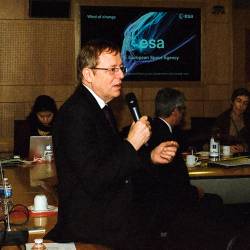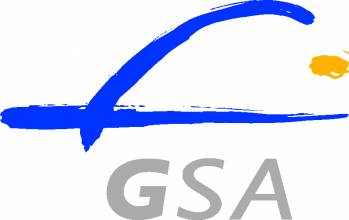The opening of the New Year at the European Space Agency (ESA) came in the wake of another spectacular launch for Europe’s GNSS program; last December, four Galileo satellites were lifted into space from Kourou, French Guyana, on board the thundering Ariane 5 launcher, by all accounts leaving witnesses awestruck.
Now back in Paris, Director General Johann-Dietrich “Jan” Woerner called the Ariane 5 an extremely reliable launcher – and that it undoubtedly is – with 82 consecutive successful launches currently under its belt. And for Galileo, that means at least one less thing to worry about.
“To have four satellites together in the same launcher and to place them into their orbits in different locations might sound trivial,” said Woerner (although it certainly does not), “but I can tell you it’s really an engineering feat, which I like very much, and it was very successful.”
Another success, he said, came last April, in the form of the results of an assessment of Galileo system performance. Here, Woerner pointed to figures obtained by the German Aerospace Center (DLR) showing a signal-in-space ranging error for Galileo of just 14 centimeters, compared to 50 centimeters for GPS, 162 centimeters for China’s BeiDou-2, and 309 centimeters for GLONASS. “This shows that Galileo is really the best in class,” Woerner said.
ESA, the European Commission and the European GNSS Agency (GSA) announced the availability of Galileo initial services at the end of 2016. “This was to allow also for industry to develop systems based on Galileo in 2017,” Woerner said, “and we now know that several smartphones are already using the data, so you can go out and buy a smartphone that is receiving the signals of GPS as well as Galileo signals. The iPhone was the last one. We already had Samsung and others, so it’s really now in your hands, if you like.
“We have 22 Galileo satellites in orbit and we will have another four satellites this year, and with that we will already have something like full capability. We are developing further and there will be more satellites in the near future, but Galileo is a fact. It’s not any longer the question ‘when will it happen?’ or all these questions we always had to answer. Galileo is now a fact; you can use it immediately and directly.”
Balancing Technical, Political Concerns
One thing that’s also a fact is that ESA will at times continue to have to deal with politically motivated constraints imposed upon it by its members and partners. As we found out at this same press event last year, choices made for political reasons, for example limiting the sourcing of certain technical components, can sometimes have a real impact on the proper functioning of ESA’s space systems.
We asked Woerner how ESA balances the sometimes-conflicting opinions of politicians as well as engineers. “We have 22 member states right now,” he said, “plus [associate members] Canada and Slovenia. And of course, we have to consider the opinions of all 22 member states, plus Canada, plus Slovenia, and there are very diverse opinions about different things. In addition, we have the European Commission as a strong partner, and EUMETSAT as a strong partner.
“I mean, it is clear, I could say it is a catastrophe to work with all of them, but instead I take it positively. It means space is in the interest of many; it is in the interest of entities, it is in the interest of countries, and this shows how important space is.”
The balancing act, he said, is a day-to-day activity: “Since my arrival at ESA [in 2015], we have created what we call an executive board, with all the directors, the inspector general, the program advisor, etcetera, etcetera. Together, we meet every two weeks, and of course we also discuss how to solve this and that issue, and how to handle… let’s not call it politics but let’s call it interests.
“Countries have interests, other entities have interests, and we have to cover that, we have to make them really satisfied with what we are doing, not to dodge these issues. Our goal is to work with space to fulfill the requirements of very different actors.”
A Thorough Understanding
Thus, as politics is drawn into space, ESA gets drawn into politics. Woerner admitted he is still finding his way in that realm. “I’m still learning, and you can never learn enough about how politics and technical aspects can interfere with each other. We do sometimes have to be a little more careful about what we say, but, again, if space were not so important, nobody would care about anything I say, political or otherwise. One thing I will never do is start to lie, to misrepresent reality, for this reason or for that reason, never ever.”
A sound approach indeed, and one that has served ESA well as it goes about the business of partnering in space, which is really, as much as anything, about building trust.
“Space plays an important role,” Woerner said, “because with space we are bridging earthly crises; we are still launching from Kazakhstan, and we are also working with Russia, so you see there is always a political element, but space remains above all these earthly borders.”






